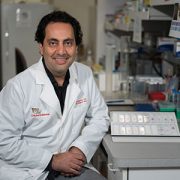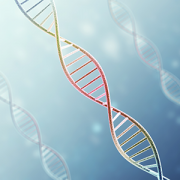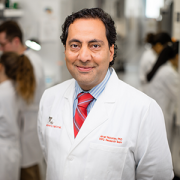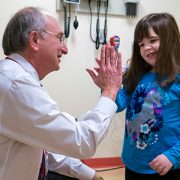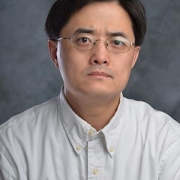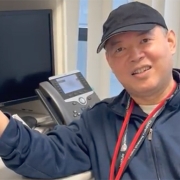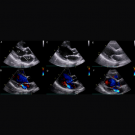Surviving pediatric diffuse intrinsic pontine glioma

Mutations in histone-encoding genes are associated with the vast majority of pediatric DIPG cases.
For more than four decades, clinicians around the nation have been giving the parents of pediatric patients diagnosed with diffuse intrinsic pontine glioma (DIPG) the same grim prognosis. In the past five years, there has been an explosion of innovative research at Children’s National Health System and elsewhere that promises to change that narrative. That’s because the black box that is DIPG is beginning to divulge its genetic secrets. The new-found research knowledge comes as a direct result of parents donating specimens, judicious shepherding of these scarce resources by researchers, development of pre-clinical models, and financing from small foundations.
From just 12 samples six years ago, Children’s National has amassed one of the nation’s largest tumor bio banks – 3,000 specimens donated by more than 900 patients with all types of pediatric brain tumors, including DIPG.
Such donated specimens have led to the identification of H3K27M mutations, a groundbreaking finding that has been described as the single-most important discovery in DIPG. Mutations in histone-encoding genes are associated with the vast majority of pediatric DIPG cases.
Histone mutations (also referred to as oncohistones) are sustained in the tumor throughout its molecular evolution, found a research team led by Javad Nazarian, Ph.D. Not only were H3K27M mutations nearly ubiquitous in all samples studied, the driver mutation maintained partnerships with other secondary mutations as DIPG tumor cells spread throughout the developing brain. Children’s National researchers have identified tumor driver mutations and obligate partner mutations in DIPG. They are examining what happens downstream from the histone mutation – changes in the genome that indicate locations they can target in their path toward personalized medicine. The value of that genomic knowledge is akin to emergency responders being told the specific house where their help is needed, rather than a ZIP code or city name, Dr. Nazarian says. While there is currently no effective treatment for DIPG, new research has identified a growing number of genomic targets for future therapeutics.“That changed the dynamic,” says Dr. Nazarian. “In DIPG clinical research, nothing had changed for 45 years. Now we know some of the genomic mutations, how the tumor was evolving – gaining new mutations, losing mutations. With precision medicine, we can target those mutations.”
Another study led by neuro-oncologist Eugene Hwang, M.D., reported the most comprehensive phenotypic analyses comparing multiple sites in a young girl’s primary and metastatic tumors. This study showed that despite being uniform, small molecules (mRNA) could be used to distinguish an evolved tumor from its primary original tumor mass.Key to this multidisciplinary work is collaboration across divisions and departments. Within the research lab, knowledge about DIPG is expanding.
Each member of the DIPG team – neurosurgery, neuro-oncology, immunology, genomics, proteomics – feeds insight back to the rest of the team, accelerating the pace of research discoveries being translated into clinical care. Among the challenges that the team will address in the coming months is outmaneuvering tumors that outsmart T-cells (immune cells).
“What is happening in the checkpoint inhibitor field is exciting,” says Catherine M. Bollard, MBChB, MD, Chief of Allergy and Immunology and Director of the Program for Cell Enhancement of Technologies for Immunotherapy. “The inhibitors work by reversing the ‘off’ switch – releasing the brake that has been placed on the T-cells so they can again attack multiple tumor proteins. The next exciting step, and novel to Children’s National, will be to combine this approach with T-cell therapies specifically designed to attack the DIPG tumors. Unlike the use of combination chemotherapy, which has had a limited impact, we hope that the novel combination of immunotherapeutic approaches will offer the hope of a potential cure.”
Dr. Hwang, another member of the multidisciplinary team, adds: “When you’re looking at the landscape – for me, at least – it starts and ends with how my patients are doing. There are kids for whom we have had great successes in improving survival rates in some cancers, like leukemia, and some where the needle has moved nowhere, like DIPG. We’re still trying to figure out the whole picture of who responds. The immune system is present in all kids. Its ability to attack is present in all kids.”
Children’s National is one of the few hospitals in the nation that conducts brainstem biopsies for DIPG and does so with very little chance of complications. The pons is like a superhighway through which nerves pass, making it instrumental in smooth operation of such vital functions as breathing, heart rate, sleeping, and consciousness. The ability of neurosurgeon Suresh Magge, MD, to perform such sensitive biopsies upends conventional wisdom that these procedures were inherently too dangerous. Within two weeks of diagnosis, genomics analyses are run to better understand the biology of that specific tumor. Within the following weeks, the tumor board occurs, and patients with DIPG are placed on therapy that best targets their tumor’s mutations.
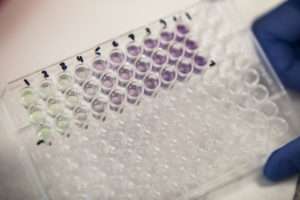
The black box that is diffuse intrinsic pontine glioma is beginning to divulge its genetic secrets.
Despite an increasing number of experimental therapies tested via clinical trials, more than 95 percent of children with DIPG die within two years of diagnoses. Biomarkers that point to DIPG – like the copies of DNA that tumors shed and leave behind in the bloodstream – could enable creation of liquid biopsies, compared with today’s surgical approach.
Children’s also is making a concerted effort to create preclinical models of DIPG. Preclinical models will be used to winnow the field of potential therapeutics to the candidates most likely to help children survive DIPG. The preclinical tumor cells will be labeled with luciferase – enzymes that, like photoproteins, produce bioluminescence – permitting the researcher to visually see the formation, progression, and response of DIPG tumors to treatment in preclinical settings.
These preclinical models could be used to test multiple drug combinations in conjunction with radiation therapy. Molecular signatures and response to treatment could then be assessed to learn how the tumor resists therapy. Due to the obligate partnerships between driver mutations and secondary mutations, the research team already knows that effective DIPG medicines will need more than one target. If there were a single mutation, that would be like having a single master key to open many locks. Multiple mutations imply that more than one key will be needed. Thus, the search for cures for DIPG will necessitate taking a multi-pronged approach.
Combined drug regimens, including those created with proprietary technology, with or without radiation, will be keys to targeting myriad mutations in order to kill tumors where they are. Those drug combinations that demonstrate they can do their jobs – slowing tumor growth, increasing chances of survival, taming toxicity – will be selected for clinical application.
Immunotherapy leverages T-cells, the immune system’s most able fighters, to help in the overall goal of extending patients’ survival. One of the most challenging aspects of pediatric brain tumors is the body does a very good job of shielding the brain from potential pathogens. Precise drug delivery means finding innovative ways for therapeutics to cross the blood-brain barrier in order to reach the tumor. The team has identified one such potential target, the protein NG2, which may represent a good target for immune therapy. The protein is expressed in primitive cells that have not become specialized – meaning there may be an opportunity to intervene before it is driven to become a tumor cell.
Related resources
Research at a Glance: The role of NG2 proteoglycan in glioma
Research at a Glance: Spatial and temporal homogeneity of driver mutations in diffuse intrinsic pontine glioma
Research at a Glance: Histological and molecular analysis of a progressive diffuse intrinsic pontine glioma: a case report


